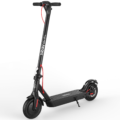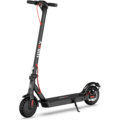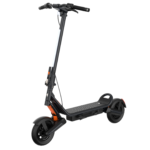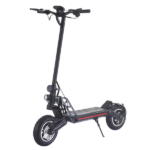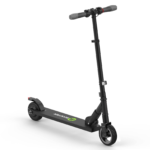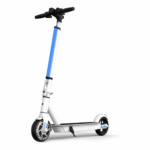- Home
- Scooters
- Electric Scooters
- Hiboy MAX Pro
Hiboy MAX Pro
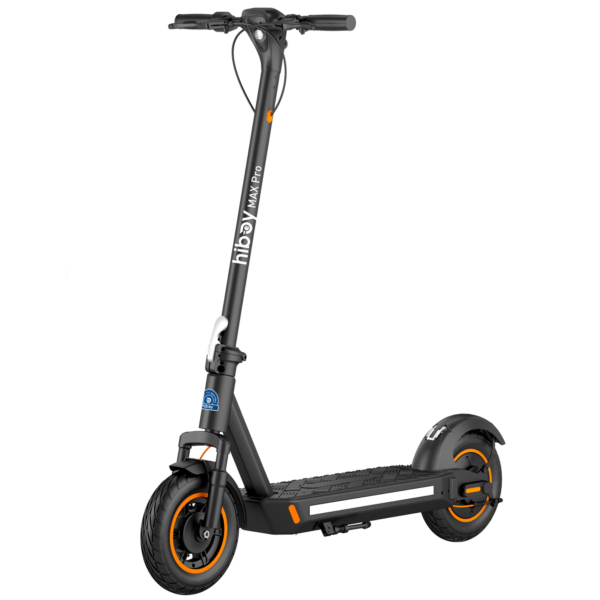

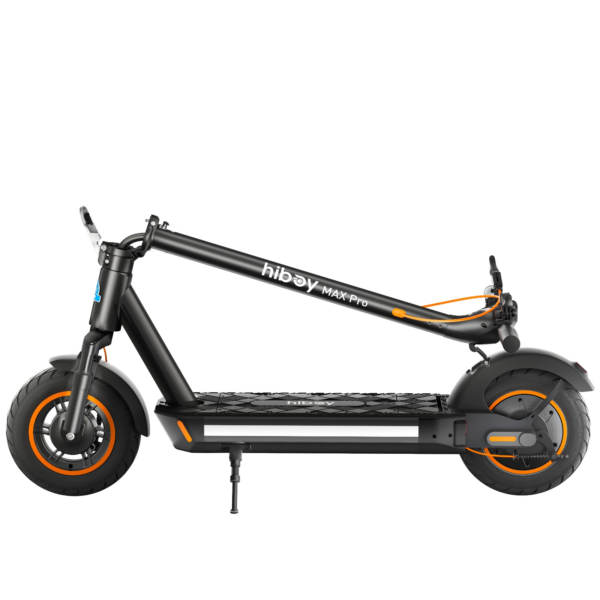
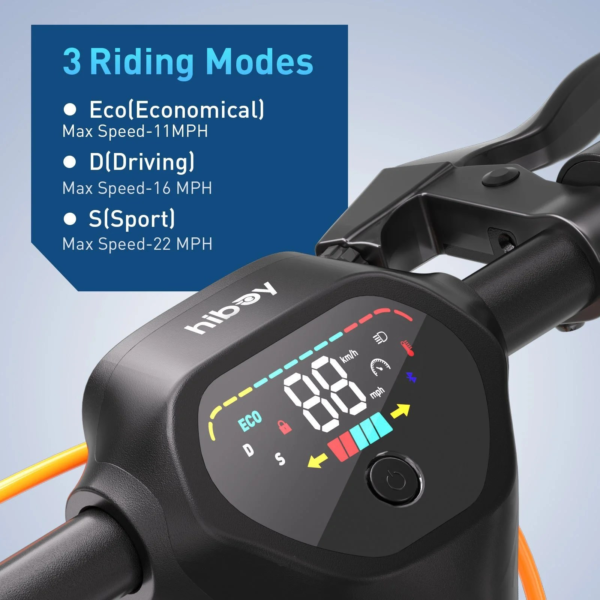
- Battery Range: 46.6 mi (75 km)
- Top Speed: 22 mph (35 km/h)
- Motor Power: 500 W nominal
- Weight Capacity: 265 lb (120 kg)
- Charging Time: 48 V 15 Ah, ~6 h charge (3 A)
- Scooter Weight: 51.6 lb (23.4 kg)
PROS
- Huge 48 V 15 Ah battery
- 11″ pneumatic tires + dual suspension
- E-brake + rear drum (low upkeep)
- Up to 46.6 miles rated range
- Stable 22 mph cruising (market-dependent)
- IPX4 splash resistance
CONS
- Heavier carry at ~51.6 lb
- Pneumatics need pressure checks
- Range dips in cold & hills
- Not ideal for frequent multi-flight carries

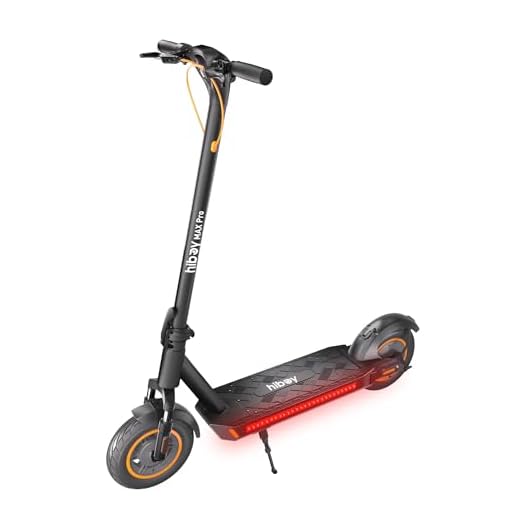
Overview: Hiboy MAX Pro—Long-Range Daily Workhorse
Quick take: stretch your loop, not your routine
The Hiboy MAX Pro targets riders who want fewer charges and more stability while keeping commuter practicality. It pairs a 48 V, 15 Ah battery with an efficient 500 W rear-hub motor (about 650 W peak). Consequently, you get a rated range up to 46.6 miles (75 km) and a market-dependent top speed near 22 mph (35 km/h). Moreover, 11-inch pneumatic tires, dual suspension (front fork + rear spring), and dual braking (electronic + drum) keep the ride calm over real streets. In short, the MAX Pro is tuned for long weekday loops and larger weekend circuits without giving up easy folding, simple storage, or straightforward service.
From the first block, the scooter feels poised rather than nervous. Larger tires raise ride height and extend the contact patch. Therefore, the chassis tracks confidently through sweepers and stays composed over expansion joints. Rear-wheel drive adds traction off the line, and the powertrain favors steady thrust over jerky bursts. As lanes compress, you can hold a line without twitch. Even on scarred asphalt, the fork and rear spring work with the air tires to smooth chatter and relax your hands.
Who the MAX Pro suits best
Choose the MAX Pro if you crave meaningful battery headroom and 11-inch tire stability. Commuters who cover 10–15 miles each way benefit most. Similarly, riders who string together city streets and suburban connectors appreciate the calm chassis. If your round trip sits in the 20–30 mile range and you would rather charge every other day, this platform fits your routine.
However, if your daily hop is five kilometers to a station plus a flight of stairs, a lighter scooter may suit better. Weight matters on stairwells. Yet, for ground-level commutes, the MAX Pro’s extra capacity provides freedom: you can detour to quieter paths, add errands after work, and still arrive with reserve.
Design and build: big-tire confidence, commuter sense
The MAX Pro’s frame blends stiffness with tidy packaging. The folding latch closes with a deliberate snap. Meanwhile, cable routing stays clean, and the deck offers generous grip. Because the ride height is taller than small-tire commuters, curbs and driveway lips feel less abrupt. Additionally, the stem remains stable at neighborhood speeds and stays composed during shoulder checks.
Dual suspension is the headline comfort feature. A short-travel front fork filters sharp hits. A rear spring damps repetitive buzz from patched asphalt. Combined with 11-inch pneumatics, the system turns rough parking-lot seams into rounded ripples. Consequently, you can hold an even pace longer without hand fatigue.
Motor and everyday speed: composed power, not spikes
The 500 W brushless rear-hub motor delivers reliable thrust. Because drive is at the rear, weight shifts onto the driven tire as you accelerate. Consequently, traction stays predictable across paint, dust, and light drizzle. Off the line, the MAX Pro steps forward briskly yet avoids twitch. At speed, the mapping prefers smooth roll-on rather than surges. This character reduces mental load in traffic and makes micro-adjustments easier.
Moreover, rear-wheel drive helps on mild grades. With a rolling start, the scooter holds momentum well within its class. It is not a hill-climb specialist; however, it rewards steady pace and clean lines. If you crest at moderate speed rather than sprinting and coasting, you conserve battery and heat.
Ride modes and control: simple choices that matter
You cycle through practical modes tuned for real routes. Eco stretches distance on long flats. Drive balances pace and battery on mixed terrain. Sport reaches the cap more easily for short merges or headwinds. Because throttle mapping stays consistent, you adapt quickly. Furthermore, cruise control (where regionally enabled) trims thumb fatigue on long, straight segments. Use it judiciously—only on clear paths—and keep a finger near the brake.
Battery, range, and charging: freedom through capacity
The 48 V, 15 Ah pack dwarfs the energy of many 36 V commuters. Therefore, you gain planning freedom. On flat paths at moderate speed, you can chase big numbers. Conversely, cold weather, headwinds, heavy loads, frequent stops, and steep climbs reduce range. That is normal for lithium packs. Even so, the MAX Pro’s reserve keeps margins healthy, which lowers stress.
Charging from low typically takes about six hours with the integrated ~3 A solution (charger specifications and starting state of charge affect this). Consequently, overnight top-ups are straightforward. If you deplete the pack often, add a midday desk top-up to reduce deep cycles. Additionally, store the battery around 40–60% if you pause riding for weeks. That habit preserves capacity through winter.
Range-stretching micro-habits
Look well ahead and coast early into reds. Hold a steady 14–18 mph when conditions allow. Choose smoother routes with fewer stops, even if they add a kilometer. Keep loads centered and low in a backpack. In wind, narrow your profile and relax your shoulders. Small changes stack into meaningful miles without costing time.
Braking and safety: consistent feel, rain or shine
Hiboy pairs an electronic brake with a rear drum. Drums live inside the hub, away from spray and grit. As a result, lever feel remains familiar in the wet, and maintenance stays light. The electronic system contributes gentle regenerative deceleration, which trims speed smoothly in traffic and reduces mechanical wear.
Practice progressive inputs in a quiet lot. Load the front with your body, then add e-brake and drum together. On damp days, lengthen braking distances and avoid sudden grabs. With ten minutes of drills, emergency stops feel routine rather than dramatic.
Lighting and conspicuity
The headlight is bright enough for suburban speeds. The taillight doubles as a brake light. Reflectors and side accents improve your silhouette when car beams pass at oblique angles. For rural connectors, consider a helmet-mounted light to aim through bends. Lightweight, high-output lights add outsized safety on dark commutes.
Ride quality and comfort: why 11-inch air matters
Comfort is the MAX Pro’s long-range story. Large, compliant casings mute high-frequency buzz that rigid small-tire scooters transmit to your hands. The fork smooths sharp hits such as expansion joints. The rear spring calms repetitive chatter on patched lanes. Therefore, you can ride longer at a steady pace without feeling rattled.
Technique still counts. Keep knees slightly bent, elbows relaxed, and your core lightly engaged. On cobbles or brick, unweight over seams and let the suspension finish the work. Switch your lead foot every few minutes on long paths. These micro-habits reduce hotspots and keep blood flowing.
Portability and storage: reasonable for the range class
At ~51.6 lb (23.4 kg), the MAX Pro is not a feather. Nevertheless, the fold is quick, the latch is positive, and the package fits most lift cars and hatchbacks. On trains, turn the bar inward so the deck parallels the wall and you occupy less aisle space. On stairs, use practiced technique: one hand under the deck near the balance point, the other at the stem, and short pauses at landings. Because the chassis is balanced, careful carries feel controlled even with the added mass.
At home, store indoors away from heaters and direct sun. After wet rides, wipe the deck, hinge, and cable inlets so grit does not work into moving parts. A simple wall hook or compact floor stand tames the footprint in small apartments.
App, dashboard, and cockpit: tools that reduce friction
The display presents speed, mode, and battery clearly. The Hiboy app adds a basic electronic lock, cruise toggles (region-dependent), and ride statistics. Use the lock for quick coffee stops; for longer errands, add a compact physical lock through a fixed object where permitted. Keep the app updated; firmware refinements can adjust throttle feel or regen strength.
Mount your phone with a rigid mechanical clamp rather than elastic bands. Position it where you can glance without turning your head. Even then, check maps at lights, not mid-corner. Attention is range and safety.
Weather and seasons: realistic expectations, quiet success
Light rain rides are feasible with care. Slow down, increase following distance, and avoid paint and metal at sharp angles. The scooter’s water protection is for splashes, not submersion. After wet rides, dry the scooter and let it breathe before stowing. In winter, store and charge indoors. Expect temporary range dips below ~10 °C as cells deliver less energy. In summer, avoid hot car trunks; heat ages cells and plastics quickly. Sensible routines extend life far more than any single upgrade.
Maintenance and ownership: five minutes that save hours
Ownership remains simple if you plan it.
- Weekly: Check tire pressures. Pneumatics protect comfort and range, but only at the right PSI.
- After wet rides: Wipe the deck, hinge, and cable entry points. Grit is a slow grinder.
- Monthly: Verify latch tightness, inspect brake cable stretch, and check bolts across bar, stem, and deck.
- Quarterly: Inspect tire tread and sidewalls; consider adding sealant if your paths are litter-prone.
Carry a compact pump at home. Keep a small patch kit in a drawer. Consequently, flats become an inconvenience, not a crisis.
Real-world scenarios and how the MAX Pro handles them
Long river trail + city return: Hold 15–18 mph in Drive mode. Use cruise only on clear straight segments. With proper pressure, the 11-inch tires and fork smooth joints so hands stay fresh.
Suburban connectors with wind: Switch to Sport for short headwind bursts, then back to Drive to save battery. Tuck elbows and stand narrow to reduce drag.
Errands after work: Range headroom means detours do not trigger anxiety. Park where people pass often. Use the app lock plus a compact physical lock for peace of mind.
Weekend loop with mixed surfaces: Lower speed on coarse chip seal to reduce buzz. Let the suspension work and avoid sharp lean on gravelly shoulders.
Because the MAX Pro keeps reserves, you plan routes for flow rather than only for distance.
Safety gear and etiquette: predictable riders win
Wear a certified helmet with a snug fit. Thin full-finger gloves add grip and protect palms. At dusk, add a backpack flasher and reflective ankle bands. Signal passes early with a bright bell. Make eye contact at junctions when possible. Ride with empathy—if a behavior would unsettle you, do not aim it at someone else. Consequently, conflict drops and average pace rises because you spend less time negotiating space.
Set-up and first ride: ten minutes that pay off
Unbox carefully and verify fasteners. Inflate tires to the recommended PSI. Charge to full before your first outing so the BMS balances cells. Pair the app, skim the tutorial, and practice slow starts, straight-line emergency stops, and gentle figure-eights in a quiet lot. Set lever angle so your wrist stays neutral, and position the bell where your thumb reaches it without shifting your grip. Those tiny choices improve control on day one.
Troubleshooting fast fixes: solve the common snags
Won’t power on: Check the charger LED, the outlet, and the charge port cap. Confirm battery level on the display.
Soft drum feel: Inspect cable tension and the arm’s leverage; a small adjustment restores bite.
Shorter range than usual: Verify tire pressure, ambient temperature, and recent speed patterns. Cold and headwinds matter.
Latch creaks: Clean grit from the hinge and retighten hardware. A dab of silicone on latch interfaces (never the brake) quiets squeaks.
Address small symptoms early. Consequently, you avoid bigger fixes later.
Buying checklist and “specifications” in context
Before you commit, run this quick list:
- Measure storage space; confirm the folded footprint fits your hallway or car.
- Time your route at a relaxed pace; add a 20% range buffer for cold or wind.
- Identify your steepest hill; plan a steady climb rather than sprints.
- Check lever reach and bar width for wrist comfort.
- Budget for a bright headlight, a compact lock, and thin gloves.
Yes, specifications matter—voltage, capacity, motor power, tire size, and brake type. Nevertheless, daily satisfaction comes from fit, control feel, storage ease, and charging reality. Match the scooter to those truths and you will ride more, with less stress.
MAX Pro vs lighter commuters: how to choose quickly
- Choose MAX Pro if you want big range, bigger tires, and higher composure over mixed surfaces. You also want fewer charges and calm pacing at suburban speeds.
- Choose a lighter 36 V model if you carry up stairs daily, ride very short hops, or need the most compact package.
- Choose higher-power performance models only if you truly need steeper-hill pace or higher top speeds; they add weight and cost that many commuters never use.
In every case, pick based on route length, surface quality, storage constraints, and charge access—not only on brochure headlines.
Final verdict: long-range calm without giving up sanity
In essence, the Hiboy MAX Pro stretches the commuter template in the directions that matter: range, stability, and comfort. Yet it remains practical to fold, store, and maintain. Ride smoothly, maintain lightly, and let the big battery shrink your mental map of the city. Because the chassis is poised, the tires are forgiving, and the brakes are consistent, your weekday loop becomes easier—and your weekend circuit grows by choice, not by chance.
Summary highlights
- Battery & motor: 48 V, 15 Ah pack + 500 W rear-hub (≈650 W peak).
- Speed & range: Market-dependent ~22 mph (35 km/h) top; rated up to 46.6 miles (75 km).
- Ride & comfort: 11-inch pneumatics + front fork + rear spring = calm hands at steady pace.
- Brakes: Electronic assist with regen + rear drum for consistent wet-weather feel.
- Weight & fold: ~51.6 lb (23.4 kg); quick, positive fold; fits lifts and hatchbacks.
- Visibility: Bright headlight, brake-taillight, reflectors/accents; add helmet light for rural links.
- Best for: Riders wanting fewer charges, bigger loops, and stable manners on city-to-suburb routes.
- Care tips: Weekly pressure checks, monthly latch/bolt/brake inspections, post-rain wipe-downs, smart charging habits.
Read the full specs once, then match them to your real route, storage, and charging plan. Consequently, you will choose a scooter you still love in six months—not just on unboxing day.
Specifications
General
| Model The Model specifies the exact version or name of the scooter. It helps identify its unique design, features, and specifications within the manufacturer’s product line. Knowing the model makes it easier to compare options, find compatible accessories, or look up support information. | MAX Pro |
| Brand The Brand identifies the manufacturer or company that designs and produces the scooter. A trusted brand is a sign of quality, reliability, and good customer support. Well-known brands often have higher standards for safety, performance, and after-sales service, giving you more confidence in your purchase. | Hiboy |
| Release Date The Release Date indicates when the scooter model was officially launched on the market. This helps you know how current the design, technology, and features are. A newer release date often means updated components, improved performance, and the latest safety or smart features. | 17 November 2025 |
| Recommended Age Recommended Age indicates the minimum age range that the scooter is designed for, based on safety, size, and ease of use. Following the recommended age helps ensure that riders can handle the scooter’s speed, weight, and controls comfortably and safely. Always check local laws and use protective gear, especially for younger riders. | Recommended 16+ |
Performance & Power
| Motor Power (Wattage) What it means: The motor power, measured in watts (W), shows how strong the scooter’s electric motor is. Why it matters: Higher wattage usually means better acceleration, more torque, and improved performance on hills or rough terrain. For example, a 250W motor is good for flat city roads and light riders, while a 500W or 1000W motor provides more power for faster speeds or climbing steep inclines. | 500 W nominal (650 W peak) |
| Top Speed The Top Speed indicates the maximum speed that the scooter can reach under optimal conditions. It’s usually measured on level ground with a fully charged battery and an average rider weight. A higher top speed allows you to travel longer distances faster, but always ensure you ride within legal speed limits and your personal comfort zone for safety. | 22 mph (35 km/h) |
| Battery Capacity Battery Capacity refers to the total amount of energy the scooter’s battery can store, usually measured in ampere-hours (Ah) or watt-hours (Wh). A higher battery capacity means you can ride longer distances on a single charge, reducing the need for frequent recharging. Keep in mind that actual range can vary depending on rider weight, terrain, speed, and weather conditions. | 48 V 15 Ah |
| Estimated Range per Charge The Estimated Range per Charge indicates the average distance the scooter can travel on a single full battery charge. This range is calculated under optimal conditions, such as flat terrain, moderate speed, and average rider weight. Real-world range may vary depending on riding style, terrain, weather, and load. A longer range means fewer recharges and greater freedom for longer trips. | Up to 46.6 mi (75 km) |
| Hill Climb Ability Hill Climb Ability describes the maximum incline or slope that the scooter can handle while maintaining stable performance. It’s typically expressed as a percentage or in degrees. A higher hill climb rating means the scooter can tackle steeper hills without losing too much speed or power. Actual climbing performance may vary based on rider weight, battery charge, and terrain conditions. | Up to 20° grades |
| Drive System The Drive System refers to how power from the motor is delivered to the wheels. Electric scooters typically use either a hub motor (directly integrated into the wheel) or a chain/belt drive system. A high-quality drive system ensures smooth acceleration, efficient power transfer, and low maintenance. The choice of drive system affects performance, noise level, and overall ride experience. | Rear hub motor (RWD) |
Charging & Electrical
| Charging Time Charging Time indicates how long it takes to fully recharge the scooter’s battery from empty to 100% using the standard charger provided. Faster charging means less downtime and more time on the road. Actual charging time may vary slightly depending on battery capacity, charger output, and environmental conditions. | Approx. 6 hours (integrated 3 A) |
| Battery Type Battery Type refers to the specific technology used in the scooter’s battery, which affects performance, lifespan, weight, and charging time. Most modern electric scooters use high-quality lithium-ion (Li-ion) batteries because they offer a good balance of energy density, durability, and low maintenance. A reliable battery type ensures consistent power delivery and longer riding ranges. | Li-ion with Smart BMS |
| Removable Battery A Removable Battery means the battery pack can be easily detached from the scooter for convenient charging and replacement. This feature allows you to charge the battery separately, swap it with a spare for extended range, or securely store it indoors in extreme weather. Removable batteries add flexibility and make it easier to keep your scooter powered up wherever you are. | External fast-charge options vary |
| Regenerative Braking Regenerative Braking is an energy-saving feature that converts some of the energy normally lost during braking back into battery power. When you slow down or brake, the motor works in reverse to generate electricity, which helps extend the scooter’s range and improves overall efficiency. This system also reduces wear on traditional brake components, leading to lower maintenance over time. | Regenerative electronic assist |
| Lighting Lighting refers to the built-in front and rear lights that enhance visibility and safety when riding in low-light conditions or at night. Good lighting helps you see the road ahead and ensures that other road users can see you. Many scooters include LED headlights, taillights, and sometimes brake lights or side reflectors for added safety and compliance with local traffic regulations. | Headlight + tail/brake + side lighting |
Build & Dimensions
| Scooter Weight Scooter Weight refers to the total weight of the scooter when fully assembled, including the battery. This affects how easy it is to carry, lift, and store the scooter when not in use. A lighter scooter is more portable and convenient for commuting, especially if you need to carry it upstairs or onto public transport. Keep in mind that a sturdy frame and quality components may add to the weight but also contribute to better durability and ride stability. | 51.6 lb (23.4 kg) |
| Maximum Rider Weight Maximum Rider Weight indicates the highest rider weight that the scooter is designed to safely support while maintaining optimal performance and stability. Staying within this limit helps ensure reliable acceleration, braking, and climbing ability, and it protects the frame, suspension, and motor from excessive strain. Exceeding the recommended limit may reduce performance and increase wear on components. | 265 lb (120 kg) |
| Deck Size Deck Size refers to the dimensions of the scooter’s standing platform. A wider and longer deck provides more foot space, allowing you to stand comfortably and adjust your stance while riding. A well-sized deck improves balance and stability, especially on longer rides or at higher speeds. Compact decks, on the other hand, help keep the scooter lightweight and portable. | Long, stable deck |
| Handlebar Height Handlebar Height refers to the distance from the deck to the handlebars, which affects your riding posture and comfort. An appropriate handlebar height helps you maintain good balance, reduces strain on your back and arms, and makes steering more comfortable. Some scooters have adjustable handlebars to fit riders of different heights, while others have a fixed height for a streamlined design. | Adult-friendly fixed height |
| Folding Mechanism The Folding Mechanism describes how easily and securely the scooter can be folded for carrying and storage. A well-designed folding system lets you quickly collapse the scooter into a compact size, making it convenient to transport on public transit, store under a desk, or fit into a car trunk. Look for sturdy latches and safety locks to ensure the scooter stays firmly in place when folded or unfolded. | Quick folding latch |
| Dimensions Folded Dimensions indicate the size of the scooter when it’s fully folded. This measurement shows how much space the scooter will take up when stored or carried, making it easier to check if it will fit in your car trunk, under a desk, or in a closet. Compact folded dimensions are ideal for commuters who need to bring their scooter on public transport or store it in tight spaces. | 47.24 × 20.87 × 51.18 in (unfolded) |
| Material Material refers to the primary construction materials used for the scooter’s frame and key components. High-quality materials like aircraft-grade aluminum, reinforced steel, or durable composites provide strength, stability, and a lighter overall weight. A sturdy material ensures the scooter can handle daily wear and tear while maintaining safety and performance. | Aluminum alloy |
Safety & Control
| Brake Type(s) Brake Type(s) describe the braking systems the scooter uses to help you slow down or stop safely. Common brake types include mechanical brakes (like drum or disc brakes), electronic brakes, and foot brakes. Many scooters combine multiple braking systems for added safety and shorter stopping distances. The type and quality of brakes affect your control, especially when riding at higher speeds or on slopes. | Electronic + rear drum brakes |
| Suspension Suspension refers to the system that absorbs shocks and vibrations while riding, providing a smoother and more comfortable ride over uneven or rough surfaces. Scooters may have front suspension, rear suspension, or dual suspension for better shock absorption and stability. Good suspension helps reduce rider fatigue and improves control, especially when riding on bumpy roads or off-road paths. | Front fork + rear spring |
| Tire Type Tire Type refers to the kind of tires the scooter uses, which directly affects ride comfort, traction, and maintenance. Common types include solid (airless) tires, pneumatic (air-filled) tires, or hybrid options. Pneumatic tires offer better shock absorption and a smoother ride on rough surfaces, while solid tires are puncture-proof and require less upkeep. The right tire type helps ensure safe handling and a comfortable ride in different conditions. | Pneumatic tires |
| Tire Size Tire Size indicates the diameter and width of the scooter’s tires, which affect ride comfort, stability, and how well the scooter handles different terrains. Larger tires generally offer better shock absorption and a smoother ride over bumps and rough surfaces, while smaller tires keep the scooter lighter and more portable. Choosing the right tire size helps ensure a balance between agility and comfort. | 11-inch |
| Kickstand The Kickstand is a built-in stand that allows you to park your scooter upright when it’s not in use. A sturdy kickstand keeps the scooter stable and prevents it from tipping over, protecting it from scratches and damage. It also makes storing and accessing your scooter more convenient, whether you’re at home, work, or on the go. | Side kickstand |
| Water Resistance Rating Water Resistance Rating indicates how well the scooter is protected against water and moisture, usually shown as an IP (Ingress Protection) rating. This rating helps you understand whether the scooter can handle light rain, splashes, or wet roads without damage. While most scooters are not fully waterproof, a good water resistance rating adds peace of mind when riding in changing weather conditions. Always avoid deep puddles or submerging the scooter to protect its electrical components. | IPX4 body |
Features & Extras
| Display/Console The Display (or Console) shows important real-time information about your ride, helping you monitor your scooter’s status at a glance. Typical displays show speed, battery level, distance traveled, and riding mode. Some models also include additional features like Bluetooth connectivity, app integration, or backlighting for better visibility at night. A clear and easy-to-read display enhances safety and convenience on every trip. | LCD dashboard |
| Ride Modes Ride Modes refer to the different speed and power settings you can choose to match your riding style or road conditions. Common modes include eco for maximum range and energy efficiency, standard for everyday balance, and sport or turbo for higher speed and stronger acceleration. Switching between ride modes allows you to customize performance, conserve battery, and ride safely in various environments. | Eco, Drive, Sport + Cruise |
| Smart App Connectivity Smart App Connectivity lets you pair your scooter with a dedicated mobile app via Bluetooth. Using the app, you can monitor real-time ride stats like speed, battery level, and range, adjust settings such as ride modes or cruise control, lock the scooter for added security, and sometimes receive firmware updates. This feature adds convenience and allows you to personalize your riding experience right from your smartphone. | Bluetooth app connectivity |
| Anti-Theft System The Anti-Theft System helps protect your scooter from unauthorized use or theft. This feature can include built-in alarms, electronic motor locks, GPS tracking, or remote locking through a mobile app. A good anti-theft system provides peace of mind when parking your scooter in public spaces, adding an extra layer of security to safeguard your investment. | Integrated charger; RWD stability |
| Cruise Control Cruise Control allows you to maintain a steady speed without continuously holding the throttle. This feature makes longer rides more comfortable by reducing hand fatigue and providing a smoother, more relaxed riding experience — especially on flat, open roads or bike lanes. For safety, cruise control can usually be easily activated or deactivated while riding. | Yes (cruise control) |
| Accessories Included Accessories Included lists the additional items that come with the scooter to enhance your riding experience and convenience. Common accessories may include a charger, kickstand, bell, lights, phone holder, or carrying strap. These extras add value by making your scooter safer, easier to use, and ready to ride straight out of the box. | Bell, reflectors, charger |
Warranty & Compliance
| Warranty Period The Warranty Period indicates how long the manufacturer guarantees the scooter against defects in materials and workmanship under normal use. A good warranty provides peace of mind, showing the brand’s confidence in its product quality. Always check what parts are covered, such as the frame, battery, and motor, and follow the maintenance guidelines to keep your warranty valid. | Typically 12 months (regional) |
| Certifications Certifications confirm that the scooter meets specific safety, quality, and environmental standards set by recognized organizations or regulatory bodies. Common certifications may include CE, RoHS, UL, or other local compliance marks, depending on your region. These certifications ensure that the scooter is manufactured to high standards and is safe and legal to use in your country. | Local e-scooter compliance |
Price Comparison





